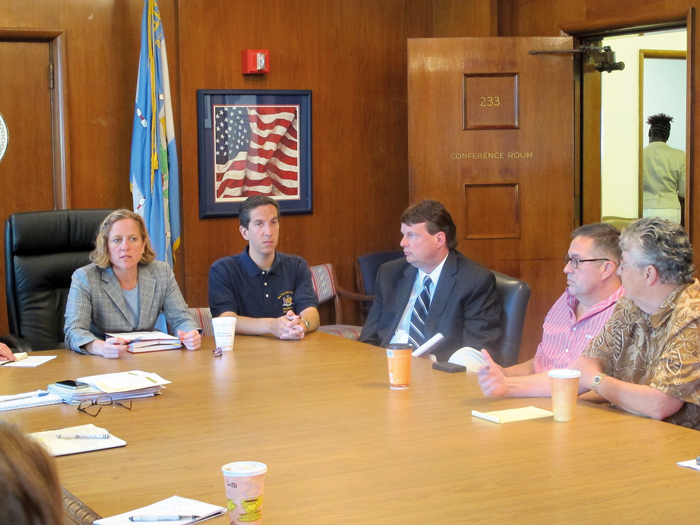File Photo
Borough President Melinda Katz (l.) leads a July 2014 meeting of the Hurricane Relief Task Force at Borough Hall.
By Michael V. Cusenza
Roughly 16 months after Superstorm Sandy tore through the borough on Oct. 29, 2012, leaving an indelible mark on the homes and minds of South Queens residents, Borough President Melinda Katz organized the Hurricane Relief Task Force—a panel of civic leaders, elected officials, and government agencies to help solve the problems that were causing pileups on the road to recovery.
Nearly six years later, Katz, who starts her new job next week as Queens district attorney, touted the work of the group and the lessons learned for future restoration and resiliency.
“The community-driven task force model should be used as a guide for how we respond to future major disasters, especially in this time of climate change,” Katz said. “A natural disaster of Sandy’s unprecedented scope requires a coordinated response that minimizes bureaucratic red tape and empowers impacted communities to work directly with government to launch and complete the herculean task of recovery. Our deepest thanks go to all of the members of the Hurricane Relief Task Force who did such a great job of delivering much needed help to those impacted by Superstorm Sandy.”
According to the borough president’s office, since its first meeting on Feb. 24, 2014, some task force highlights include:
Streamlined issuance of necessary permits: In June 2014, at the urging of the task force, the State Department of Environmental Conservation issued a “blanket” permit to speed up Sandy-related construction in areas adjacent to wetlands. Also, in the fall of 2016, the panel prompted the City to facilitate zoning relief for Sandy-damaged properties.
Cleared roadblocks regarding Small Business Administration disaster loan applications: The task force worked with the federal SBA to fix a bureaucratic problem with its disaster loan program that had led to some loan applicants to be improperly excluded from the City’s Build It Back home rebuilding program.
Spearheaded outreach to Build It Back applicants: In June 2015, at the request of the task force, staffers from the Mayor’s Office of Housing Recovery Operations joined elected officials in reaching out to those who had become disaffected with Build It Back to try to convince them to stay with the program.
Helped to reduce delays in elevating homes: In April 2016, the task force worked to shorten the time between when a BIB home was elevated and when it was returned to its foundation. The group also coordinated with utilities to expedite the return of utility services to elevated homes.
Pushed for resolution of construction delays: In December 2016, the task force successfully sought the creation of a “red-tagging” process for BIB construction jobs where work had stopped for more than 48 hours. Under this process, HRO aggressively investigates why such work has stopped and quickly moves to have it resume.
Persuaded the City to start “war room”: In December 2016, the task force convinced HRO to create a “war room” with dedicated staff to handle intergovernmental coordination and assist with sign-offs, inspections and other issues.

